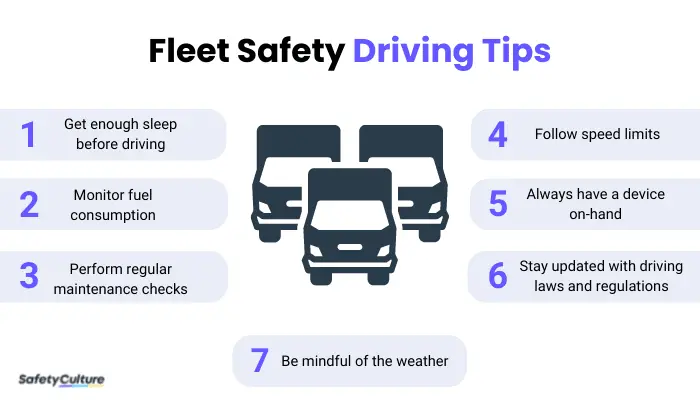What is Fleet Safety?
Fleet safety is the development and promotion of safety guidelines across a transport organization. Prioritizing fleet safety can help reduce the number of vehicular accidents that not only impact the lives of employees, but also the performance of the entire fleet.
Role in Fleet Management
Fleet management refers to all the tasks done to keep a company’s fleet of vehicles (e.g., taxis, trucks, and buses) running smoothly, on time, and within budget. There are many different aspects to fleet management, but ultimately, they all refer back to fleet safety.
Fleet safety is considered to be the most important aspect of fleet management. Not only does fleet safety affect the transport of goods, but it also affects the vehicles and the drivers manning them. Statistics from the Centers for Disease Control and Prevention (CDC) show that vehicle crashes are the leading cause for workplace fatalities, resulting in more than 29,000 deaths from 2003 to 2018. These vehicular accidents are more common in the pharmaceutical industry, where multiple fleets are sent out and received each day.
Multiple car accidents also tend to lower morale and motivation in the workplace, especially with drivers and those involved directly with the fleets. Companies with more known accidents also tend to be unappealing to those looking to be fleet drivers, as these people would not want to risk endangering themselves. This includes not only drivers of heavy goods vehicles but also motorcycle riders for delivery and logistics services.
Additionally, fleet managers often operate on a safety-first mindset because a safe fleet is more cost-efficient. In the US, car crashes cost fleet managers an average of 500 to 2,200 dollars. Although companies often have a budget allotted for vehicular accidents, the costs can pile up, leading to multiple financial losses. The same can be said for vehicle maintenance and equipment maintenance, both of which are also essential to safety in fleet management.
Importance of Safe Driving
Since fleet safety is a key priority for those in fleet management, many employers and fleet managers invest in fleet driving safety programs by partnering with external training schools. A typical fleet driving safety program is much like a regular personal driving lesson but with added tasks and procedures, depending on the drivers’ respective company policies.
In a driving school, fleet drivers are oriented on what should be the proper safety practices when manning their vehicles. These schools usually provide the vehicles for the drivers, and drivers are also given lessons on basic emergency procedures for when accidents happen.
On the other hand, some companies choose to create their own training courses and incorporate it into their existing fleet safety programs instead. By having their own fleet driving safety course, companies have more control over the sessions since they can use their own vehicles and save on extra partnership costs. Some base their courses on what driving schools offer, but some use online courses as their basis instead.
Improve your EHS Management
Cultivate a safe working environment and streamline compliance with our EHS solutions.
Explore nowThere are now many online driving-related courses to choose from, making it easier for companies to host their own driving lessons. For general courses, there are driver safety and traffic rules and regulations courses. There are also more job-specific driving courses available now, such as one for those working as drivers in the gig economy.
Regardless of how fleet driving safety is taught, the overall idea of maintaining and promoting driver safety is retained. Some general ways fleet drivers can keep safe on the road are to:

Fleet Safety Driving Tips
- Get enough sleep before driving
- Monitor fuel consumption
- Perform regular maintenance checks on the company vehicles to be used
- Follow speed limits
- Always have a device on-hand to call their managers in case of emergencies
- Stay updated with driving laws and regulations
- Be mindful of the weather
Having a checklist on-hand can also help with driving safely. The most common use for checklists when driving is for vehicle upkeep, but checklists can also be used to ensure the following:
- Drivers have attended all training sessions and completed a DVIR checklist.
- All necessary tools and equipment are complete and in the right place.
- The number of packages to deliver are the same as planned.
- Drivers themselves are in good, working physical condition.
Create Your Own DVIR Checklist
Eliminate manual tasks and streamline your operations.
Get started for FREESafetyCulture (formerly iAuditor) for Fleet Safety
Consider using SafetyCulture to improve your fleet safety procedures. SafetyCulture is a digital checklist inspection app that you can use on both desktop and mobile, allowing you to perform inspections for your fleet, wherever and whenever.
Using SafetyCulture, you can:
- Create your own checklists or use pre-made templates from the Public Library
- Schedule your vehicle or tool inspections
- Ensure your drivers are well-equipped with the proper tools, attire, and emergency kits in their vehicles
- Require your drivers to add photos or notes of their vehicles and packages before and after delivery
- Create and use QR codes for performing quick inspections on-the-go
- Store accomplished checklists in the cloud and share them with everyone in your company
- Raise problems and observations by declaring Issues, assigning Actions, or giving a Heads Up
- Generate analytical reports based on finished inspections and use them to improve your fleet safety plans
- Export your accomplished inspection reports as Word or PDF files




